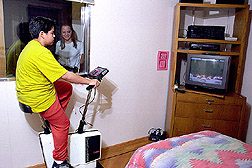This page has been archived and is being provided for reference purposes only. The page is no longer being updated, and therefore, links on the page may be invalid.
|
Read the magazine story to find out more. |
Study Tracks Obesity Among U.S. Hispanic ChildrenBy Alfredo FloresJune 4, 2003 Understanding factors that contribute to obesity in the nation's Hispanic children and youth is the objective of investigations under way at the Children's Nutrition Research Center (CNRC) in Houston, Texas. Scientists with the Agricultural Research Service, in collaboration with the Southwest Foundation for Biomedical Research in San Antonio, Texas, are in the third year of a five-year study called "Viva la Familia," which is Spanish for "long live the family." Nancy Butte, an ARS energy expert at the CNRC, is the study's principal researcher. Childhood obesity is more prevalent among Hispanic children than those of any other ethnic group in the United States. For the first time, researchers are investigating the causes of childhood-onset obesity within this population group. They hope to identify genetic and environmental factors that make some children more prone to excess weight gain. Preliminary results have already shown that 40 to 60 percent of the variation in obesity, also known as adiposity, may be attributed to genetics. In-depth metabolic and physiologic testing of volunteer children and their parents has been done in three phases at the CNRC's Metabolic Research Unit. During the first phase, the volunteers were checked for weight and height and for vital signs. Both children and parents received a body composition scan to measure lean tissue and body fat. Parents gave blood samples, while the children underwent an exercise test and answered questions about their food consumption. In the next phase, the children's energy expenditures were measured, and blood samples were taken for genetic and biochemical analysis. At the end of this one-day test, the children put on a device that monitored their physical activity for the next three days. A year later, the children's weight, height and body composition were again measured. This phenotypic information was used to make connections between specific genes or genetic patterns and gain in weight, body fat and other factors. The CNRC is operated by Baylor College of Medicine in cooperation with Texas Children's Hospital and ARS, the U.S. Department of Agriculture's chief scientific research agency. More information about this research is in the June issue of Agricultural Research magazine. |

